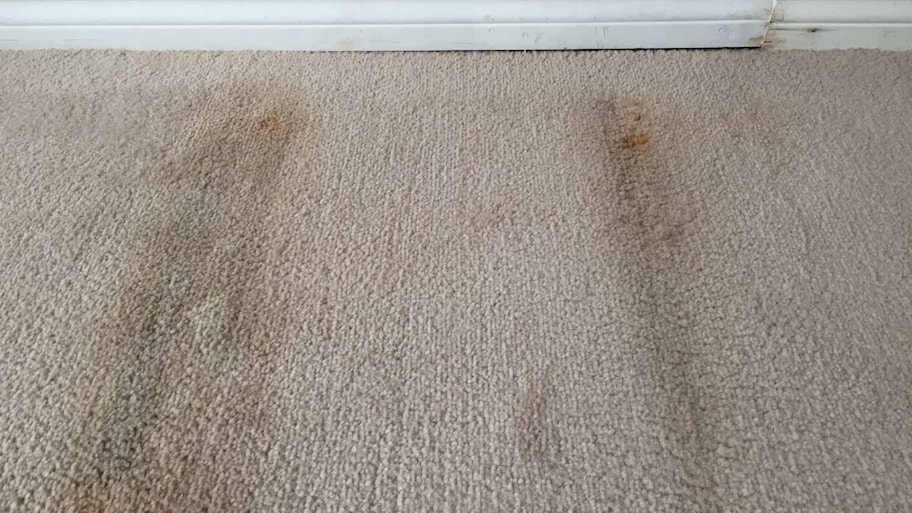How To Get Mildew Smell Out of Carpet For Good
If your home isn’t smelling its best, take a closer look at your carpet


You want your home to be clean, warm, and inviting. If no matter how often you clean, your home still smells a bit musty, mildewed carpets may be to blame. Keep reading to learn more about what causes mildew to form and how to get mildew smell out of your carpet.
How Did My Carpets Mildew?
Carpets can mildew when they are exposed to conditions that promote mold and mildew growth. The main factors that contribute to carpet mildew include:
Excessive moisture: The most common cause of carpet mildew is excessive moisture. This moisture can come from various sources, such as leaks, floods, high humidity, or spills that are not adequately dried. Carpets that are not thoroughly dried after being exposed to moisture are at high risk of developing mildew.
Poor ventilation: Insufficient ventilation in a room can lead to a buildup of humidity. When the air is stagnant and doesn't circulate well, it can create a damp environment, especially in areas where carpets are laid, such as basements and enclosed spaces.
Water damage: Carpets are highly susceptible to mildew after water damage incidents, such as leaks from roofs, pipes, or appliances. If the carpet is not thoroughly dried and treated after such incidents, mildew growth is likely.
Spills and stains: Organic materials like food and beverages, if not cleaned properly and promptly, can provide a food source for mold and mildew. When these substances are ground into the carpet fibers, they can create an environment conducive to mildew growth.
Improper cleaning: If carpets are not cleaned using appropriate methods and are left excessively wet during the cleaning process, it can lead to mildew growth. Carpet cleaning should be done using methods that allow for thorough drying, and excess moisture should be removed.
High humidity: In areas with consistently high humidity levels, even without a specific water incident, carpets can absorb moisture from the air. Over time, this moisture can lead to mildew growth.
Poorly maintained HVAC systems: Heating, ventilation, and air conditioning (HVAC) systems that are not adequately maintained can contribute to high indoor humidity levels. If the HVAC system does not adequately dehumidify the air, it can create a damp environment, encouraging mildew growth.
Signs of Mildewed Carpet

Not sure if mildew is to blame for your musty-smelling carpets? Here are a few signs that mildew may be causing your carpets to smell bad.
You smell a musty odor: One of the most common signs of mildew in carpet is a musty or moldy smell. If your carpet smells unpleasant, even after cleaning, it could be an indication of mildew growth.
You see discoloration: Mildew can cause discoloration on the carpet fibers. You might notice dark or black spots on the surface of the carpet. Sometimes, the affected area can appear greenish or grayish.
You feel dampness: If the carpet feels damp or wet to the touch, especially in areas that are not typically exposed to moisture, it could be a sign of mildew growth underneath the carpet.
You have allergic reactions: For some individuals, exposure to mildew can cause allergic reactions such as sneezing, coughing, itchy eyes, or skin rashes. If these symptoms worsen when you're at home and improve when you leave, it could be due to mildew in the carpet.
You notice peeling or lifting: Mildew can cause the carpet to peel or lift away from the floor. This is especially true for wall-to-wall carpets that are glued down. The moisture weakens the adhesive, causing the carpet to lose its grip.
You find visible mold: In severe cases, you may actually see mold growing on the surface of the carpet. Mold can appear fuzzy, slimy, or powdery and is often green, black, or white in color.
You develop health issues: Prolonged exposure to mildew can lead to health problems, particularly for individuals with respiratory conditions or weakened immune systems. If people in your household are experiencing unexplained health issues, it could be due to mildew exposure from the carpet.
If you suspect mildew in your carpet, it's essential to address the issue promptly. Mold and mildew growth can spread quickly and may require a professional mold removal service or a professional cleaning, or even replacement of the affected carpet to ensure your home remains a healthy environment.
How to Remove Mildew Smell From Carpet

Removing that unpleasant mildew smell from carpets can be challenging, but it's not impossible. Here's a step-by-step guide to get rid of mildew smells.
Dry the area: Ensure the affected area is completely dry. Use fans and dehumidifiers to expedite the drying process. Mildew thrives in damp environments, so eliminating moisture is crucial.
Vacuum thoroughly: Use a high-quality vacuum cleaner with a HEPA filter to thoroughly clean the carpet. Vacuuming helps remove loose mildew spores and debris.
Sprinkle baking soda: Liberally sprinkle baking soda over the affected area. Baking soda is excellent for absorbing odors. Let it sit for several hours, ideally overnight and then vacuum it up. Repeat this process if necessary.
Use a white vinegar mixture: Next, mix equal parts of water and white vinegar in a spray bottle. Lightly spray the affected area, but do not oversaturate the carpet. Vinegar helps neutralize odors. Let it sit for a few hours, then blot the area with clean, dry towels to absorb excess moisture.
Apply enzymatic cleaner: Enzymatic cleaners are designed to break down organic compounds, including mildew. Follow the instructions on the cleaner, usually involving spraying it on the affected area and letting it sit for a specified time. Afterward, blot the area with clean, dry towels.
Consider professional cleaning: If the mildew smell persists after trying the above methods, consider hiring a professional carpet cleaning service near you. Professionals have access to more potent cleaning solutions and equipment, which can effectively eliminate stubborn odors.
Replace carpet padding: In severe cases where the mildew odor has penetrated the carpet padding, it might be necessary to replace the padding. This is often the most effective way to completely remove the smell.
How to Prevent Carpets from Mildewing
Mildew growth in carpets can be prevented with regular maintenance and a few precautionary measures. Here are some handy tips to keep your carpets mildew-free:
Control indoor humidity: Maintain indoor humidity levels below 60 percent. Consider using a dehumidifier, especially in damp areas like basements.
Embrace proper ventilation: Ensure good air circulation in your home. Use fans and open windows to allow fresh air in, particularly after cooking, showering, or using appliances that generate moisture.
Manage spill cleanup immediately: Clean up spills promptly and thoroughly. Use clean, white cloths or paper towels to blot the spill and remove as much moisture as possible. Consider using a wet/dry vacuum for larger spills.
Commit to regular cleaning: Vacuum carpets regularly to remove dirt and debris. This prevents organic materials from accumulating, which can be a food source for mildew. It’s a good idea to schedule professional carpet cleaning at least once a year, especially in high-traffic areas. Professional cleaning not only removes dirt but also helps eliminate mold spores.
Use area rugs and mats: Use area rugs and mats in high-traffic areas and places prone to spills, like entryways and kitchens. These can be easily cleaned or replaced if they become damp or soiled.
Install proper carpet padding: Ensure your carpet is installed with breathable padding. Moisture-resistant padding can prevent water from being trapped under the carpet, reducing the risk of mildew.
Do regular inspections: Periodically inspect your carpets, especially in areas susceptible to moisture, like basements and bathrooms. Look for signs of dampness, and if you find any, address the issue promptly.
Increase sunlight exposure: Allow sunlight into your home by opening curtains and blinds during the day. Sunlight has natural disinfectant properties and can help keep mildew at bay.
DIY vs. Hiring a Pro
It can be much cheaper to clean your carpets on your own (especially if you already own a wet/dry vacuum and only need to buy cleaning supplies), but hiring a professional carpet cleaner may give you some peace of mind that the job is done right. Professional carpet cleaning is $180 on average but can cost between $123 and $240. If you think you have bigger mold issues in your home, you can expect to spend much more on mold remediation costs.
Frequently Asked Questions
To neutralize mildew smell, you can use natural deodorizers like baking soda or activated charcoal. Baking soda absorbs odors; sprinkle it liberally on the affected area, let it sit for a few hours, then vacuum it up. Activated charcoal, available in pouches, works similarly. Vinegar, with its natural acidic properties, can also neutralize odors. Mix equal parts water and vinegar, spray the affected area lightly, then blot it with a dry cloth. Enzymatic cleaners are effective too, breaking down odor-causing compounds.
The duration of mildew smell in carpets depends on several factors, including the extent of moisture, cleanliness, and ventilation. If promptly addressed, the smell can diminish within a few days to a couple of weeks after thoroughly drying and cleaning the carpet. However, in severe cases or if not properly treated, the smell might persist. Persistent odors could indicate deeper mildew growth, requiring professional cleaning or, in extreme cases, carpet replacement to completely eliminate the smell.
